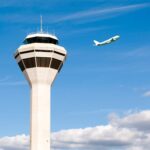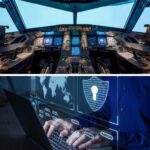
Article-at-a-Glance
-
Special codes ensure clear communication and safety in the skies, especially for private jets.
-
The phonetic alphabet helps avoid confusion over radio transmissions.
-
Common phrases like “Roger” and “Wilco” confirm receipt and understanding of messages.
-
Emergency codes like “Mayday” and “Pan-Pan” signal urgent situations.
Discretion is paramount for private jet communication, particularly with VIP passengers.

Decoding the Sky: Private Jet Communication Essentials
When you think about flying, you might picture the freedom of soaring above the clouds. But for those who pilot private jets, the sky is not a place of chaos but one of the most tightly controlled spaces on Earth. And that control is maintained, in large part, through communication.
Why Pilots Use Special Codes
Imagine trying to have a conversation in a noisy room. Now, imagine that room is moving at hundreds of miles per hour, thousands of feet in the air. That’s what it’s like to communicate in a private jet. To be heard over the engine’s roar and to be understood despite different accents and languages, pilots use special codes.
These codes do more than just cut through noise; they prevent misunderstandings that could lead to delays or, worse, accidents. For instance, the word ‘five’ can sound like ‘fire’, which could cause unnecessary panic. That’s why pilots will say “fife” for the number five.
Most importantly, these codes are universal. Whether you’re flying over the Sahara or the Pacific, the language of the sky is consistent.
Aircraft Radiotelephony Alphabet Basics
To ensure that every letter in a message is understood, pilots use what’s called the phonetic alphabet. You might have heard it in movies — “Alpha” for ‘A’, “Bravo” for ‘B’, “Charlie” for ‘C’, and so on. This alphabet turns every word into an unmistakable sequence of terms.
Here’s a simple example. To spell ‘jet’, a pilot would say “Juliet Echo Tango.” It’s clear, concise, and leaves no room for error. This is critical because, in aviation, even small mistakes can lead to big problems.
The Pilot’s Lexicon: Understanding Common Phrases
Now, let’s get into some of the phrases you might hear if you’re listening to pilot chatter.
Example: A pilot wants to confirm that they’ve received a message from air traffic control (ATC). They might respond with “Roger” to indicate they’ve heard the message, followed by “Wilco,” which means they will comply with the instructions.
Besides that, there are codes for all sorts of situations. “Squawk 7500” might sound like a line from a spy movie, but it’s actually the code a pilot would use to discreetly inform ATC that their aircraft is being hijacked.
Navigating Through “Squawk Codes”
Squawk codes are four-digit numbers that pilots input into the aircraft’s transponder, which then sends a signal to air traffic control radar. These codes provide a quick way to communicate the plane’s situation without clogging the airwaves with chatter. For instance, “Squawk 7700” is used in general emergencies, “Squawk 7600” indicates a radio failure, and, as mentioned, “Squawk 7500” signals a hijacking.
Secret Codes – Enabling Sky-High Confidentiality
In the world of private aviation, confidentiality is king. The passengers aboard these aircraft often include celebrities, business tycoons, and political figures. To protect their privacy, pilots and air traffic controllers use a series of discreet communication practices.
These practices include using non-specific flight numbers, avoiding mentioning individuals by name over the radio, and sometimes even using encrypted communication systems to ensure that conversations remain private.
Importance of Discretion in Private Aviation
The stakes are high when it comes to privacy in private jet travel. Pilots must be adept at balancing the need for effective communication with the requirement for discretion. This means knowing when to use codes and when to rely on more secure means of communication, such as the coordination between private jet pilots and air traffic control.
Codes Used for High-Profile Passengers
For high-profile passengers, codes and call signs become even more critical. For example, the President of the United States flies in ‘Air Force One’, a call sign known worldwide, but less well-known is that other call signs are used when the President is aboard a different type of aircraft, such as ‘Marine One’ for helicopters or ‘Executive One’ when private aircraft are used.
Technology and Innovations in Jet Communication
The technology behind private jet communication is constantly evolving. The latest systems are designed for clarity, range, and security. They must work seamlessly across different airspaces and be compatible with international standards.
State-of-the-Art Communication Systems
Modern private jets are equipped with advanced communication systems that include satellite phones, high-frequency radios, and even internet connectivity. These systems allow passengers to stay connected, whether it’s for business or personal reasons, while also ensuring that pilots can maintain constant contact with air traffic control.
One such system is the Aircraft Communications Addressing and Reporting System (ACARS), which automates data transmission between the aircraft and ground stations. ACARS can send messages about the aircraft’s status, which helps with tracking and can alert ground services to any maintenance needs upon landing.
Another key component is the Traffic Collision Avoidance System (TCAS), which helps pilots avoid mid-air collisions by alerting them to the presence of nearby aircraft and advising on avoidance maneuvers.
-
Satellite phones for global reach
-
High-frequency radios for communication with ATC
-
Internet connectivity for passenger use
-
ACARS for automated data transmission
-
TCAS for collision avoidance
The Future of Aviation Communication: What to Expect
Looking ahead, we can expect even more sophisticated systems. The future of aviation communication lies in technology that can increase bandwidth, allowing for faster and more reliable data transfer. This might include the use of AI to predict and manage flight paths to avoid congestion and potential conflicts.
There’s also the possibility of integrating more secure, blockchain-based communication systems to protect the confidentiality of the communications within private aviation.
Learning the Language of the Skies
For those intrigued by the world above the clouds, learning the language of aviation can be a fascinating endeavor. Whether you’re an aspiring pilot or simply an aviation enthusiast, understanding the codes and phrases used in the sky can give you a new appreciation for the complexity and beauty of flight.
Resources for Aviation Enthusiasts
There are numerous resources available for those interested in aviation communication. Books, online courses, and flight simulation software can provide a solid foundation in the basics of aviation lingo and radiotelephony procedures.
Beyond the basics, there are also forums and clubs where enthusiasts can discuss and learn from experienced pilots and air traffic controllers.
Steps to Mastery: Tips for Aspiring Pilots
If you’re aiming to take to the skies yourself, here are some steps to mastering aviation communication:
-
Start with the phonetic alphabet and common aviation terms.
-
Listen to live ATC communications available online to get a feel for the pace and style of real-world aviation chatter.
-
Enroll in a pilot training program to get hands-on experience.
-
Practice, practice, practice. Like any language, proficiency comes with use.
Remember, clear communication is just as important as being able to handle the aircraft. It’s the key to safety, efficiency, and a smooth flight experience for everyone on board.
FAQs
Let’s answer some common questions you might have about private jet communications.
What is the Universal Language of Aviation?
The universal language of aviation is English. Regardless of their native language, all pilots and air traffic controllers across the globe are required to communicate in English. This standardization is crucial for safety and ensures clear understanding among international flight crews and controllers.
Why Are Aviation Codes So Important?
Aviation codes are vital because they provide a concise and clear way of communication that transcends language barriers and reduces the risk of misunderstandings. In the fast-paced environment of aviation, these codes facilitate quick information exchange, which is essential for maintaining the safety and efficiency of flights. To ensure proper coordination between private jet pilots and air traffic control, understanding and using these codes correctly is paramount.
Example: When a pilot says “Squawk 7700,” air traffic control immediately knows there is a general emergency without needing further explanation, allowing them to act quickly to assist the aircraft.
How Are Emergency Situations Communicated in Aviation?
In aviation, emergencies are communicated using standardized phrases and codes. The most widely recognized emergency signal is “Mayday,” which is used to indicate a life-threatening emergency. “Pan-Pan” is used for urgent situations that are not immediately life-threatening. These calls help controllers prioritize and respond effectively.
Emergency transponder codes, also known as “squawk” codes, are also used. Pilots input a specific four-digit code into the aircraft’s transponder to indicate the nature of the emergency to air traffic controllers.
-
Squawk 7700: General emergency
-
Squawk 7600: Loss of radio communication
-
Squawk 7500: Unlawful interference (e.g., hijacking)
Can Aviation Communications Be Hacked or Intercepted?
While aviation communication systems are designed to be secure, no system is completely immune to hacking or interception. However, the aviation industry continuously implements advanced security measures, including encryption and strict protocols, to safeguard against unauthorized access and ensure the integrity of communications.
Private jet communications often employ additional layers of security, given the need for confidentiality among their clientele.
Are There Differences in Communication Across Different Types of Aircraft?
While the basic principles of aviation communication apply across all types of aircraft, there can be differences in the communication equipment and protocols used. For instance, private jets may have access to more advanced communication systems than smaller general aviation aircraft. Military aircraft also use specialized encrypted systems for secure communications.
However, when it comes to interacting with air traffic control, all aircraft adhere to the same communication standards for clarity and safety.
In conclusion, the world of private jet communication is a fascinating blend of technology, protocol, and precision. By understanding the secret codes of the sky, we gain insight into the intricate dance that keeps our skies safe. Whether you’re an aspiring pilot, an aviation enthusiast, or simply curious, the language of aviation is an open book, waiting to be explored. Set out on an unforgettable journey! Click here to request a quote or commence your extraordinary travel experience: Launch Your Adventure.












